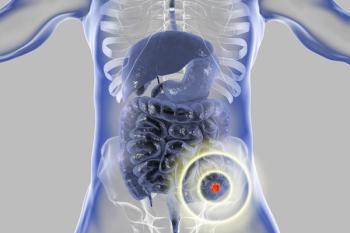
Oncology NEWS International
- Oncology NEWS International Vol 19 No 4
- Volume 19
- Issue 4
High dietary polyamines may foster colorectal adenomas
A high intake of dietary polyamines, which are commonly found in orange juice, corn, red meat, peas, and nuts, has been linked to the size and grade of colorectal adenomas found on screening colonoscopy.
A high intake of dietary polyamines, which are commonly found in orange juice, corn, red meat, peas, and nuts, has been linked to the size and grade of colorectal adenomas found on screening colonoscopy. Increased polyamine synthesis and inflammation have been associated with colon carcinogenesis, but by decreasing the intake of dietary polyamines, the cancer process might be slowed, according to recent research.
The study, led by Kavitha P. Raj, MD, at the University of California, Irvine, evaluated the role of dietary polyamines in the occurrence of sporadic adenomas and asked whether these compounds might interfere with the preventive benefit of difluoromethylornithine (DFMO)/sulindac (Clinoril) (2010 Gastrointestinal Cancers Symposium abstract 279).
Study patients had a history of at least one resected adenoma but no cancer or hereditary colon cancer syndromes. Patient data were obtained from a previous adenoma prevention trial (see Fact Box), and a self-administered food frequency questionnaire was collected to determine total dietary polyamine intake. Rectal biopsy specimens were obtained to evaluate tissue polyamine content, which was compared with dietary intake.
FACT Reduction in metachronous colon ca In a previous multicenter phase III study, Dr. Meyskens and colleagues showed that inhibition of polyamines with DFMO and the COX inhibitor sulindac reduced the incidence of metachronous colorectal cancer by 70% and advanced adenomas by 90% (
AACR 2008
abstract LB-142).
For comparison, the 222 patients were categorized into two dietary polyamine groups:
According to the results, adenomas larger than 1 cm were found in 43.6% of persons in the highest quartile group compared with 26.4% in the lowest quartiles (P = .01); advanced adenomas were identified in 52.7% vs 35.9% (P = .03) and high-grade adenomas in 32.7% vs 20.4%, respectively (P = .06), Dr. Raj reported.
Tissue levels of both spermine and spermidine were significantly elevated in patients in the highest quartile dietary group compared with the lower quartile groups.
"In the baseline characteristics, we found a strong association between dietary and tissue polyamine levels," she said. "Higher dietary polyamines were associated with larger and more advanced adenomas."
Patients with the lowest intake experienced an 81% reduction in the risk of adenoma recurrence, an 89% reduction in adenomas larger than 1 cm, a 91% reduction in high-grade adenomas, and a 94% reduction in advanced adenomas (adjusted for aspirin intake). All differences were statistically significant and striking, Dr. Raj noted.
Interestingly, an interaction was observed between dietary polyamine and benefit from DFMO/sulindac (Clinoril; see Fact Box). The highest intake altered the magnitude of risk reduction such that a preventive benefit was seen only in the lower dietary quartiles.
VANTAGE POINT Remarkable results, but dietary effects are tough to demonstrate
- ROBERT BRESALIER, MD
The current study was well designed and executed, said Dr. Bresalier, distinguished professor of GI oncology at Houston's M.D. Anderson Cancer Center. Dr. Bresalier lectured on chemoprevention at the 2010 GI Cancers Sympsosium.
"The idea of inhibiting polyamines as a means of altering tumor progression has been around for some time," he said, adding that Dr. Raj and colleagues "produced quite remarkable results, in fact, probably the best we have seen for chemoprevention."
In the current subanalysis, there was an indication that perhaps dietary polyamines "overwhelmed" the treatment effect of DMFO/sulindac, he said, "though whether that is the case or not remains to be seen. It's an interesting observation."
"The problem with studies like these is that dietary effects are notoriously difficult to demonstrate," Dr. Bresalier cautioned. "From a mechanistic point of view, the subanalysis is of interest, but its practical application is questionable. The problem is that diets are complicated, and sorting out one component from the other is very difficult."
Articles in this issue
over 15 years ago
Thyroid Cancer: Shifts in Surgical Management and Follow-upover 15 years ago
Duke doctor named new chair of NCCN board of directorsover 15 years ago
Study sheds light on lung cancer and African Americansover 15 years ago
Everolimus achieves ‘potent’ results in rare form of NHLover 15 years ago
Who's Newsover 15 years ago
Analgesic use may decrease postmenopausal estrogen levelsover 15 years ago
Healthcare legislation boosts future of cancer care servicesover 15 years ago
Complete resection of kidney mets ups overall survivalNewsletter
Stay up to date on recent advances in the multidisciplinary approach to cancer.

















































































